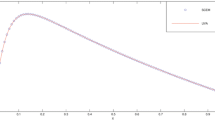Abstract
This paper presents a high order multiplication perturbation method for singularly perturbed two-point boundary value problems with the boundary layer at one end. By the theory of singular perturbations, the singularly perturbed two-point boundary value problems are first transformed into the singularly perturbed initial value problems. With the variable coefficient dimensional expanding, the non-homogeneous ordinary differential equations (ODEs) are transformed into the homogeneous ODEs, which are then solved by the high order multiplication perturbation method. Some linear and nonlinear numerical examples show that the proposed method has high precision.
Similar content being viewed by others
References
Tirmizi, I. A. and Twizell, E. H. Higher-order finite-difference methods for nonlinear second-order two-point boundary-value problems. Applied Mathematics Letters, 15, 897–902 (2002)
Ilicasu, F. O. and Schultz, D. H. High-order finite-difference techniques for linear singular perturbation boundary value problems. Computers and Mathematics with Applications, 47, 391–417 (2004)
Reddy, Y. N. and Chakravarthy, P. P. An exponentially fitted finite difference method for solving singular perturbation problems. Applied Mathematics and Computation, 154, 83–101 (2004)
Awoke, A. and Reddy, Y. N. An exponentially fitted special second-order finite difference method for solving singular perturbation problems. Applied Mathematics and Computation, 190, 1767–1782 (2007)
Wang, S. and Li, Z. C. An analysis of a conforming exponentially fitted finite element method for a convection-diffusion problem. Journal of Computational and Applied Mathematics, 143, 291–310 (2002)
Li, X. G., Chan, C. K., and Wang, S. The finite element method with weighted basis functions for singularly perturbed convection-diffusion problems. Journal of Computational Physics, 195, 773–789 (2004)
Tobiska, L. Analysis of a new stabilized higher order finite element method for advection-diffusion equations. Computer Methods in Applied Mechanics and Engineering, 196, 538–550 (2006)
Teofanov, L. and Roos, H. G. An elliptic singularly perturbed problem with two parameters II: robust finite element solution. Journal of Computational and Applied Mathematics, 212, 374–389 (2008)
Zhu, G. Q. and Chen, S. C. Convergence and superconvergence analysis of an anisotropic nonconforming finite element methods for singularly perturbed reaction-diffusion problems. Journal of Computational and Applied Mathematics, 234, 3048–3063 (2010)
Kadalbajoo, M. K. and Patidar, K. C. Exponentially fitted spline in compression for the numerical solution of singular perturbation problems. Computers and Mathematics with Application, 46, 751–767 (2003)
Reddy, Y. N. and Chakravarthy, P. P. Numerical patching method for singularly perturbed twopoint boundary value problems using cubic splines. Applied Mathematics and Computation, 149, 441–468 (2004)
Kadalbajoo, M. K. and Arora, P. B-splines with artificial viscosity for solving singularly perturbed boundary value problems. Mathematical and Computer Modelling, 52(5–6), 654–666 (2010)
Tan, S. J. and Zhong, W. X. Numerical solution of differential Riccati equation with variable coefficients via symplectic conservative perturbation method (in Chinese). Journal of Dalian University of Technology, 46(S1), S7–S13 (2006)
Fu, M. H., Lan, L. H., Lu, K. L., and Zhang, W. Z. The high order multiplication perturbation method for time-varying dynamic system (in Chinese). Scientia Sinica-Physica, Mechanica and Astronomica, 42, 185–191 (2012)
O’Malley, R. E. Introduction to Singular Perturbations, Academic Press, New York (1974)
Gu, Y. X., Chen, B. S., Zhang, H. W., and Guan, Z. Q. Precise time integration method with dimensional expanding for structural dynamic equations. AIAA Journal, 39(12), 2394–2399 (2001)
Zhong, W. X. and Williams, F. W. A precise time step integration method. Proceedings of the Institute of Mechanical Engineers Part C: Journal of Mechanical Engineering Science, 208(C6), 427–430 (1994)
Kevorkian, J. and Cole, J. D. Perturbation Methods in Applied Mathematics, Springer-Verlag, New York (1981)
Nayfeh, A. H. Perturbation Methods, Wiley, New York (1979)
Author information
Authors and Affiliations
Corresponding author
Additional information
Project supported by the National Natural Science Foundation of China (Key Program) (Nos. 11132004 and 51078145)
Rights and permissions
About this article
Cite this article
Zhang, Wz., Huang, Py. High order multiplication perturbation method for singular perturbation problems. Appl. Math. Mech.-Engl. Ed. 34, 1383–1392 (2013). https://doi.org/10.1007/s10483-013-1753-x
Received:
Revised:
Published:
Issue Date:
DOI: https://doi.org/10.1007/s10483-013-1753-x
Key words
- singular perturbation problem (SPP)
- high order multiplication perturbation method
- two-point boundary value problem
- boundary layer




